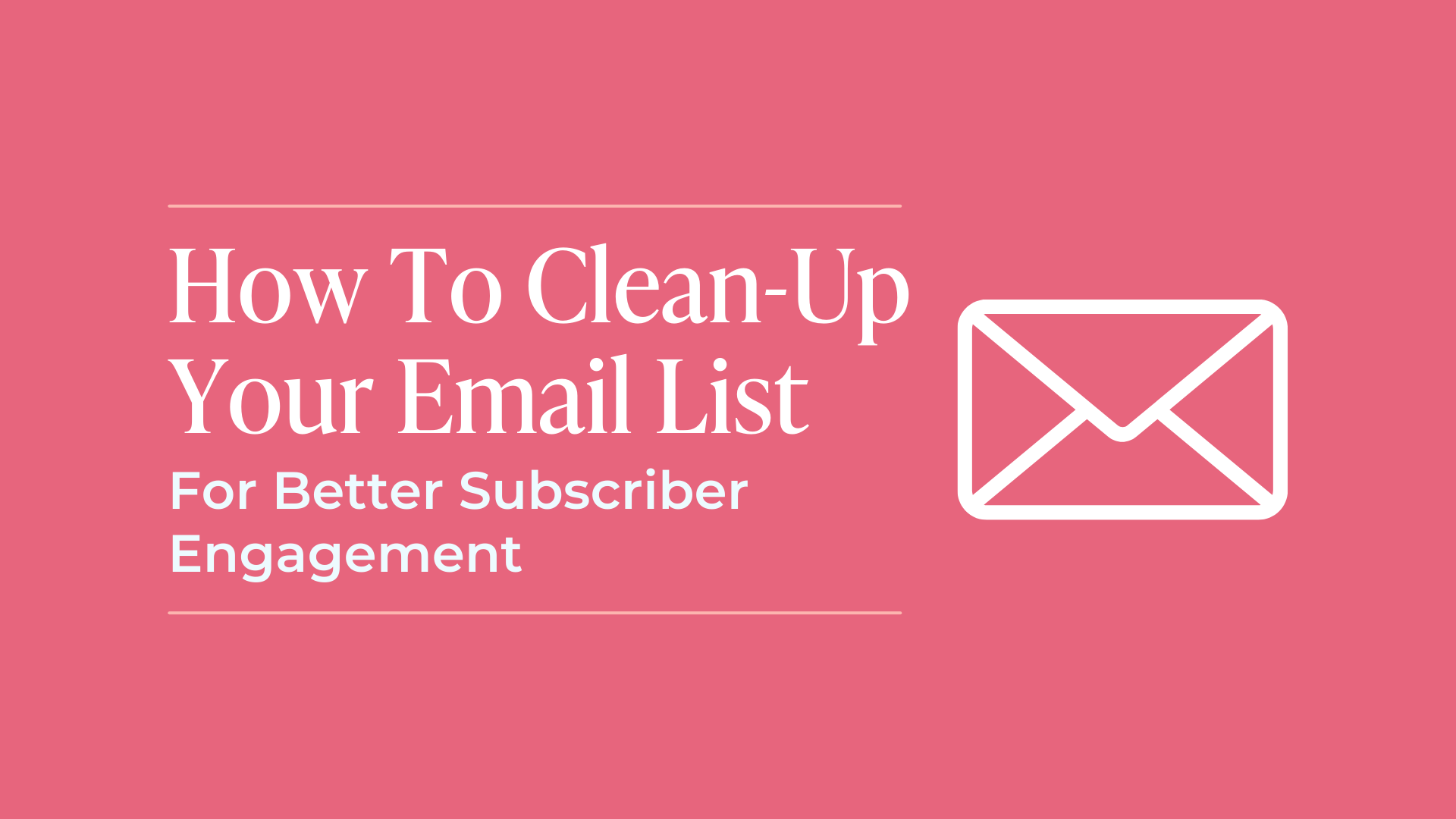How to Clean-Up Your Email List of Cold Subscribers For Better Subscriber Engagement
Having an engaged email list gives you a warm audience interested in working with you and buying what you offer.
With so much content out there focused on growing your email list, it’s easy to overlook the importance keeping your email list “clean.” A clean list means your subscribers are actively interested and engaged with your content.
That’s what I want to focus on today!
Topics covered in this blog:
Why list clean-up is so important
What is a COLD subscriber and how to identify one
How often to remove cold subscribers from your list
How to re-engage cold subscribers before removing them (because you can get some contacts active again!)
Why It’s Important To Clean Your Email List and Remove Cold Subscribers
Email list clean-up is also known as Scrubbing Your List. This means deleting the people who aren’t engaging with the emails you’ve been sending - they don’t open or click on any of your emails.
These people are called “COLD Subscribers.”
Here are the main reasons why you should scrub your list of cold subscribers:
Scrub cold subscribers to improve email deliverability
When you keep emailing people who consistently ignore your content, it hurts your email deliverability. It brings your stats and email sender reputation down, which could affect your emails being seen by people who are actually interested.
It’s like constantly trying to ask someone out on a date when they’ve repeatedly given you signals they’re not interested anymore. It’s not because you’re not a great catch, you’re just going after the wrong person.
Save money on your email marketing plan by scrubbing cold subscribers
Most email marketing providers charge you based on how many contacts you have on your email list. There’s no point continuing to pay for a higher-priced plan if a large number of those contacts aren’t even looking at your emails.
Sample pricing from ActiveCampaign based on 1,000 contacts
More accurate metrics & realistic expectations
At first it sounds like the more email subscribers you have, the better. But your total number of subscribers doesn’t tell the whole story.
You want to know the true number of active people who not only open the emails but actually click the links inside them. (It’s the clicks that best indicate their willingness to buy a particular offer.)
Then you’ll have a more realistic expectation for your email marketing efforts.
For example, instead of feeling disappointed if half of your total contacts don’t open a single sales email, ask yourself:
How many contacts were already cold to begin with and were unlikely to have ever bought anything?
Who Is A COLD Subscriber?
Cold Subscriber
This is typically defined as a person who has not opened or clicked any of your emails in the past 90 days.
If a person has been on your list fewer than 30 days, then it’s anyone who hasn’t opened or clicked any of your emails in the past 30 days since subscribing.
By the way, the engagement I really want you to focus on is CLICKS rather than OPENS. That’s because open rates aren’t always reliably tracked.
Why Do Subscribers Go Cold?
Common reasons people stop engaging with your emails include:
They’ve lost interest. This especially happens if you’ve pivoted your business and are talking about very different topics than before. It’s understandable if your older contacts aren’t interested in your new content and just haven’t taken the time to unsubscribe. Doing an email list clean-up ensures your audience’s interests align with what you’re currently offering.
They can’t find your emails. Your awesome emails may have ended up in their Junk, Spam or Promotions folders instead of the main inbox. Or their inbox is flooded with emails everyday and yours is getting lost in the noise.
You’re, um, not actually sending them emails. If you’ve been inconsistent about emailing your list (like it’s been months since your last one), then it's natural that they lost interest or forgot about you.
How Often Should You Clean-Up Your Email List?
Start with doing list clean-up at least once per year. This works well if you’ve grown your list “organically,” meaning people joined your list without any paid ads. For example, they found you on Google, social media, a podcast, or heard you speak at an event.
There are several other scenarios when you’ll want to do additional list clean-up.
If you ran ads for a launch
If you ran ads to a webinar registration page or some other lead-capture form, then those contacts may not be as strong or loyal as those who found you organically. If you’re launching a program multiple times a year, I recommend doing list clean-up twice a year. Time your list clean-up in the months leading up to a launch so you can have more accurate numbers of who you’ll market to..
If you receive a large list of subscribers from a group event
Some summit or virtual event hosts will share the email addresses of all event attendees to the participating speakers. As a summit speaker, you could get a flood of new email subscribers to introduce into your world.
This has happened with several of my clients who received thousands of email addresses when they participated in virtual summits.
However, realize that not everyone will be interested in you specifically to stick around for the long term. You’ll want to regularly send them content within those first 30 days of adding them to your list to make sure they’re engaged and are a good fit.
ConvertKit Handles Cold Subscribers
If 25% of your subscribers are “cold”: Some email service providers will automatically mark cold subscribers for you. I use ConvertKit, which actually has a dropdown that identifies the people who haven’t opened or clicked emails in the last 90 days.
If the number of cold subscribers is close to 25% of your total subscribers, then it’s time to do list clean-up.
How to re-engage cold subscribers before removing them
(Because you can get some people active again!)
First, make sure that you’ve actually been consistently emailing your list for the past 90 days. You need to give people opportunities to engage with your content and that can’t happen if you didn’t send anything in the first place. If you’ve been sending weekly or bi-weekly emails, then you’ll have enough data to determine if someone is truly cold.
Now that we have that out of the way, let’s dive into the steps!
Step 1: Create a new email tag for your cold subscribers
Create a new email tag labeled SUB: Cold. This is the label that will identify the contacts who are considered cold subscribers.
Step 2: Add the email tag to your cold subscribers
Once you have your list of cold subscribers, add the email tag you just created. Most email platforms give you the ability to bulk add a tag to multiple subscribers at once.
Step 3: Write three re-engagement emails
The re-engagement email sequence is a series of three emails that ONLY gets sent to contacts who were tagged with SUB: Cold.
You’re sending three emails to give these folks several chances to raise their hand and say, “Hey, I still want to be part of your email list!” They raise their hand by clicking a link in the email to prove they still want to hear from you. (More on that in Step 5.)
You can set up an automation that will remove the SUB: Cold tag from contacts once they click the link. So if your contact Jane clicks the link in email #1, she won’t get emails #2 or 3.
The three emails are sent out over the course of one week since not everyone opens their emails immediately.
The message in each email has 3 parts:
Remind people what your email list is about
Tell them they need to click a link if they still want to be on your email list
Explain that if they don’t click, they’ll be automatically removed from your list in a week.
Below is an example of one of my re-engagement emails:
Step 4: Create confirmation page for re-engaged subscribers
So what happens when a contact clicks the link in your re-engagement email? The link should take them to a simple web page that confirms they’re staying on your list.
The link to this web page is what you’ll use in all three emails, and you’ll also use it in Step 5.
Below is an example of my confirmation page. Notice I included links to blogs they might’ve missed in my prior emails.
Step 5: Set up automation to remove the tag from people who click the link
You should be able to set up an automation that will remove the SUB: Cold tag from contacts once they click the link. So if your contact Jane clicks the link in email #1, she won’t get emails #2 or 3 because the tag will no longer apply to her.
ConvertKit Tip
Here’s a rule I set up in ConvertKit to automatically remove the SUB: Cold tag from people who click the link that takes them to the confirmation page
Step 6: Send emails to cold subscribers only
Choose the date when you’ll send Email #1. Send Email #2 three days later, then Email #3 four days after that. This gives subscribers a week to take action.
Step 7: Delete remaining cold subscribers
Once you’ve sent all three emails, take a look at how many contacts still have the SUB: Cold tag. Select anyone who still has the cold tag and delete/unsubscribe them from your list! They will no longer impact your email deliverability because they will not be included in future emails you send.
Also check if you’re able to downgrade your pricing plan. By removing cold subscribers, your total amount of contacts may qualify for a lower priced plan. You’ll likely have to reach out to Customer Support directly if you can’t find a way to do this in your account settings.
Conclusion
Don’t be afraid to remove people from your list. I know, it can be nerve-wracking and disappointing to do this, especially if it took a lot of work to get these subscribers in the first place.
But these are people who ultimately aren’t the best fit for your community and the digital empire trying to build - and that’s OK.
Remember, your goal is to build an email list of dream clients. You want people who are interested in what you offer, who you can serve at the highest level, and who genuinely want to work with you.
Have questions about this process or other email marketing questions? Comment below!
Happy scrubbing! 😄
Klara
Need help building an email marketing strategy?
My VIP Days are dedicated to fleshing out those ideas to help you drive more traffic to your products and services. Click here to learn more about VIP Days.








